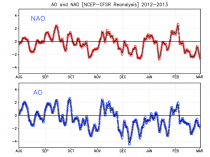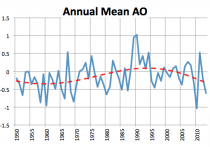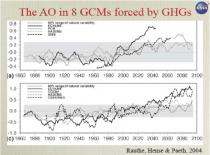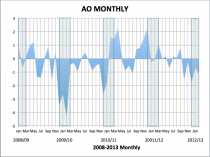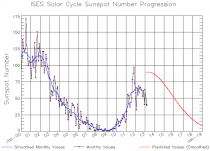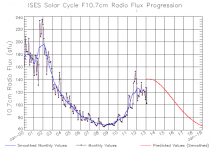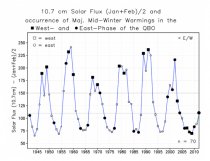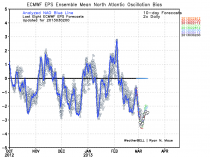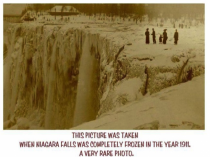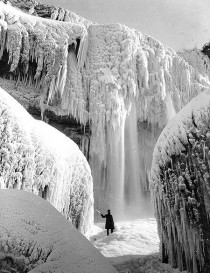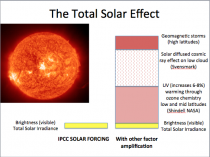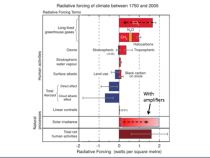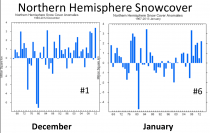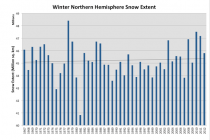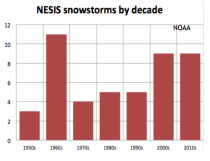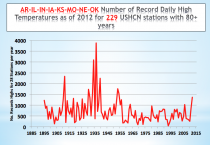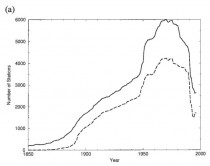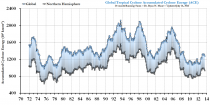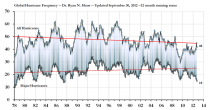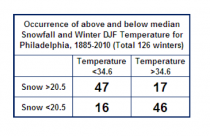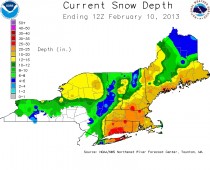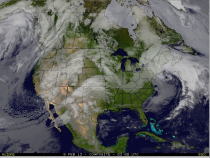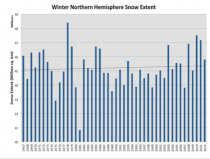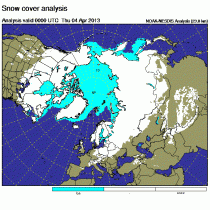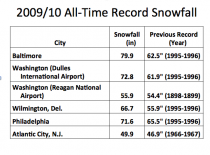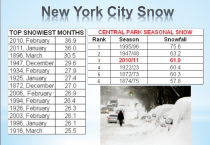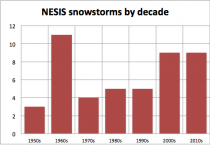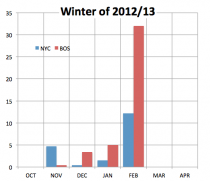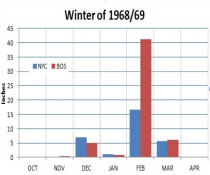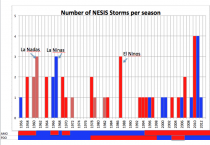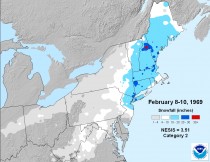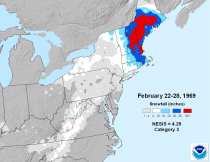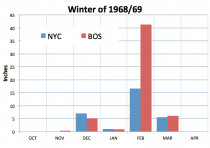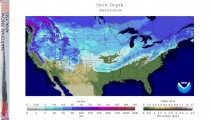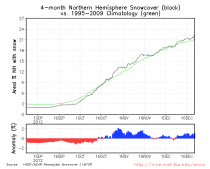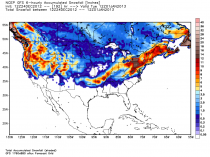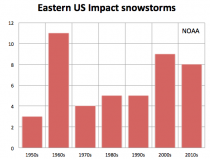Update: See this YOUTUBE video with Nir Shaviv on solar vs AGW
By Joseph D’Aleo, AMS Fellow, CCM
The AO and NAO has been predominantly negative this winter continuing a trend sine the 1990s. It has produced a brutal winter in Russia, especially Siberia into northern and sometimes central China with cold spells and snow in Europe and the United States.
After a rebound last year, we seem to be still on a trend down since 1990. Climate models had indicated an upward trend.
Note how the AO which reached record low levels in 2009/10 winter rebounded late in the 2010/11 winter and stayed higher in 2011/12 before falling again this year.
That matches the solar cycle which bottomed out from 2007/08 through 2009/10 before spiking late in 2010/11 and peaking at the start of the 201/12 winter. it has fallen since and February came in with a SSN of just 38, well below the forecast (red).
Solar flux too dropped to 104 sfus at a time we are supposed to be near solar max for this cycle.
Notice how stratospheric warmings, which produce high latitude blocking and a negative AO and last for 4 to 6 weeks which were rare and mostly near max and min have been almost every years since the sun went ‘asleep’.
The AO and NAO are forecast to stay very low.
NASA SHOWED A CONNECTION OF THE SUN WITH NAO
Shindell et al in the following NASA Earth Observatory story a decade ago related the Maunder Minimum conditions and blocking to the low solar ultraviolet which through ozone chemistry warms the upper atmosphere in low and middle latitudes. When the sun is quiet the UV which changes 6-8% in the 11 year cycle stays near solar minimum levels. The solar flux is said to be a good proxy for the UV.
See the temperatures their ozone/UV model showed for the Maunder Minimum versus normal solar times. See the - NAO!!
Here is what they wrote:
Many things can change temperatures on Earth: a volcano erupts, swathing the Earth with bright haze that blocks sunlight, and temperatures drop; greenhouse gases trap heat in the atmosphere, and temperatures climb. From 1650 to 1710, temperatures across much of the Northern Hemisphere plunged when the Sun entered a quiet phase now called the Maunder Minimum. During this period, very few sunspots appeared on the surface of the Sun, and the overall brightness of the Sun decreased slightly. Already in the midst of a colder-than-average period called the Little Ice Age, Europe and North America went into a deep freeze: alpine glaciers extended over valley farmland; sea ice crept south from the Arctic; and the famous canals in the Netherlands froze regularly - an event that is rare today.
The impact of the solar minimum is clear in this image, which shows the temperature difference between 1680, a year at the center of the Maunder Minimum, and 1780, a year of normal solar activity, as calculated by a general circulation model. Deep blue across eastern and central North America and northern Eurasia illustrates where the drop in temperature was the greatest. Nearly all other land areas were also cooler in 1680, as indicated by the varying shades of blue. The few regions that appear to have been warmer in 1680 are Alaska and the eastern Pacific Ocean (left), the North Atlantic Ocean south of Greenland (left of center), and north of Iceland (top center).
If energy from the Sun decreased only slightly, why did temperatures drop so severely in the Northern Hemisphere? Climate scientist Drew Shindell and colleagues at the NASA Goddard Institute for Space Studies tackled that question by combining temperature records gleaned from tree rings, ice cores, corals, and the few measurements recorded in the historical record, with an advanced computer model of the Earth’s climate. The group first calculated the amount of energy coming from the Sun during the Maunder Minimum and entered the information into a general circulation model. The model is a mathematical representation of the way various Earth systems -ocean surface temperatures, different layers of the atmosphere, energy reflected and absorbed from land, and so forth -interact to produce the climate.
When the model started with the decreased solar energy and returned temperatures that matched the paleoclimate record, Shindell and his colleagues knew that the model was showing how the Maunder Minimum could have caused the extreme drop in temperatures. The model showed that the drop in temperature was related to ozone in the stratosphere, the layer of the atmosphere that is between 10 and 50 kilometers from the Earth’s surface. Ozone is created when high-energy ultraviolet light from the Sun interacts with oxygen. During the Maunder Minimum, the Sun emitted less strong ultraviolet light, and so less ozone formed. The decrease in ozone affected planetary waves, the giant wiggles in the jet stream that we are used to seeing on television weather reports.
The change to the planetary waves kicked the North Atlantic Oscillation (NAO) - the balance between a permanent low-pressure system near Greenland and a permanent high-pressure system to its south - into a negative phase. When the NAO is negative, both pressure systems are relatively weak. Under these conditions, winter storms crossing the Atlantic generally head eastward toward Europe, which experiences a more severe winter. (When the NAO is positive, winter storms track farther north, making winters in Europe milder.) The model results, shown above, illustrate that the NAO was more negative on average during the Maunder Minimum, and Europe remained unusually cold. These results matched the paleoclimate record.
Note: The Maunder Minimum was followed by quiet periods in the 106 and 212 cycles shown as the Dalton Minimum and the early 1900 quiet era.
A quiet sun leads to more -NAO, more cold winter weather. We may be entering at least a Dalton like Minimum, but even if it was like the early 1900s, it could get very cold after the Atlantic follows the Pacific into its cold phase with the low solar (next minimum due around 2020).
See Niagara Falls in 1911.
The solar brightness (visible changes only 0.1% in the 11 year cycle), but there are significant amplifiers. We do not have a good estimate of their magnitude but they are much greater than the brightness. They include the UV discussed, the diffusion of cosmic rays which affects the nucleation of low clouds (Svensmark effect) and geomagnetic which produces warming in higher latitudes (ionization visible as the aurora).
This suggest the IPCC has greatly underestimated the solar effect while the flattening of temperatures for 17 years as per Pachauri and the Hadley center suggest they have seriously overestimated ANY greenhouse warming from CO2. I don’t profess to know exactly what the number are but the arrows suggest the direction.
So if the sun continues in its doldrums, we should see more interesting winters. Europe and Asia have had some brutal cold the last 5 years and very heavy snows. Many European scientists are said to be baffled, bewildered and confused by the cold not forecast by their super computer models and some are beginning to believe they don’t understand the climate they way they thought they did. We have had 4 of the top 5 snowiest winters for the hemisphere for the last decade. Remember the forecasts that snow would become a rare commodity.
Wait until the AMO follows the PDO negative with the quiet sun for broad North American cold, but it should be interesting and snow should be in the picture most years.
We have not gotten the winter ranking yet, but I would guess 2012/13 will rank high up given December was snowiest ever for the hemisphere and January #6. We were well above in February too.
Let’s se if we can add another to the NESIS list. I have added the early February blizzard. If we had a comparable list from NOAA for the central, we might have had one or two this past month and maybe another to come.
By Anthony Watts,. Watts Up With That
A couple of days ago there was this PR from the University of Illinois at Urbana-Champaign. Icecap Note: Announcing the continuing ignorance on parade tour Wuebbles has been on even to the equally clueless Boxer committee with equally clueless other speakers
I decided it was just too ridiculous to get any traction. I was wrong, an even more ridiculous press release followed this one. Only one problem; Wuebbles doesn’t understand the difference between reality and reporting bias- Anthony
University of Illinois atmospheric sciences professor Donald Wuebbles will present a talk about how climate change is increasing the number of severe weather events at the 2013 AAAS meeting.
Climate change’s costly wild weather consequences
CHAMPAIGN, Ill. - Throughout 2012, the United States was battered by severe weather events such as hurricanes and droughts that affected both pocketbooks and livelihoods. Research suggests that in the coming years, U.S. five-day forecasts will show greater numbers of extreme weather events, a trend linked to human-driven climate change.
Donald Wuebbles, a professor of atmospheric sciences ![]() at the University of Illinois at Urbana-Champaign, will discuss extreme weather in a presentation Feb. 15 at the annual meeting of the American Association for the Advancement of Science in Boston.
at the University of Illinois at Urbana-Champaign, will discuss extreme weather in a presentation Feb. 15 at the annual meeting of the American Association for the Advancement of Science in Boston.
In recent decades, multi-day heat waves and severe precipitation have become more frequent. For example, in the U.S. in the 1950s, the number of days that set record high temperatures was equal to the number of days that set record low temperatures. By the 2000s, the United States was twice as likely to see a record high as a record low.
“Human-driven climate change is in fact driving changes in severe weather, and that leads to a lot of potential impacts in both humans and wildlife that end up being costly in many different ways,” Wuebbles said.
As the global climate changes, normal weather patterns are altered. This is because the increasingly warmer atmosphere holds larger amounts of water vapor, which energizes storms, Wuebbles said.
The consequences of severe weather are much greater than the disappointment of a missed picnic or the inconvenience of a power outage. Weather-related disasters incur huge expenses, taxing both public funds and private equity. According to the National Oceanic and Atmospheric Administration, 11 extreme weather events costing more than $1 billion each occurred in 2012.
“What we’ve seen in general is that the number of billion-dollar events has increased over the last three decades,” Wuebbles said. “It’s not just hurricanes, it’s really a number of different types of weather extremes that are increasing, and that’s what the worry is.”
In his talk, Wuebbles will discuss the current understanding of severe weather in relation to the science of climate change, as well as speak about the issues and uncertainties that will affect the U.S. and world in the coming years.
----------
OK today we have this press release from AAAS:
Scientists Say Wild Weather Is Here to Stay
Cable news junkies, take heart: if you love wall-to-wall coverage of hurricanes, wildfires and superstorms, your future viewing schedules will be jam-packed.
Researchers at the AAAS Annual Meeting said that wild weather events like Superstorm Sandy and the severe Texas drought are the new normal in North America, as human-driven climate change has made these events more intense and more frequent.
This GOES-13 satellite image was captured on Oct. 31 at 1240 UTC as Sandy’s circulation was winding down over Pennsylvania. Sandy had been downgraded a remnant low pressure area. Credit: NASA GOES Project
Consider these facts:
- In the 1950s, the number of days that set record high temperatures in the U.S. was equal to the number of days that set record low temperatures. By the 2000s, record highs were twice as likely as record low.
- The amount of precipitation falling in the heaviest rain and snow events in the United States has increased by nearly 20% since the 1950s.
- Since the 1970s, the Atlantic Ocean has seen substantial increases in nearly every measure of hurricane activity, from frequency to storm intensity.
“The scientific analyses are now indicating a strong link between changing trends in severe weather events and the changing climate,” said Donald Wuebbles, an atmospheric scientist from the University of Illinois. “Every weather event that happens nowadays takes place in the context of a changed background climate.”
“Globally the temperatures are higher, the sea levels are higher, and there is more water vapor in the atmosphere, which energizes storms. So nothing is entirely natural anymore,” he said. “The background atmosphere has changed and continues to change due to human activity.”
Extreme weather took political center stage earlier this week, when U.S President Barack Obama mentioned Superstorm Sandy and other severe weather events in his State of the Union speech.
However, the president was careful to note that “no single event makes a trend” an idea echoed by the researchers at a AAAS news briefing.
“While a particular heat wave may have still have occurred in the absence of human-induced warming,” Wuebbles explained, “it would not have been as hot, or lasted this long, and such events would not occur as frequently.”
Ok Bozo explain the dust bowl of the 1930s and the 7 year drought from 1949 to 1956.
Ecologists and wildlife biologists have been steadily compiling evidence that climate change has profound effects on plants and animals, affecting where they thrive and when they breed or flower, among other events. But University of Texas at Austin biologist Camille Parmesan said some of these changes also can be driven by extreme weather events - even just a few days of extreme heat or rainfall.
Climate change interacts with other factors such as pollution and shrinking habitats to affect plant and animal populations, Parmesan acknowledged. But, she said, studies of coral reefs and other natural habitats suggest that “if we reduce these other human stresses, we actually can increase resilience and resistance in natural ecological systems.”
It remains to be seen whether humans can be similarly resilient in the face of extreme weather, the researchers said. The past holds several examples of other societies that did not fare so well under severe climate change.
Tree-ring records from the American Southwest, for example, suggest that drought during the 13th century may have driven the residents of Mesa Verde, Colorado to flee their fields and homes. “The historical record shows us a community that may have failed environmentally,” said David Stahle, a tree-ring scholar from the University of Arkansas. “We are doing the same thing now in terms of our heavy consumption of water and fossil fuels.”
Wuebbles said he has talked with farmers in the American Midwest who are already changing planting times and seed types in response to recent years of severe drought and floods. And other states are grappling with the financial implications of a future of weather extremes.
Texas State climatologist John Nielsen-Gammon has been tracking the fallout from his state’s ongoing drought, which he said was triggered more by extreme high temperatures than a lack of rainfall.
Reservoirs are at their lowest levels since the 1990s, and the state legislature will meet this spring to discuss a water plan that ensures supplies for the next 50 years. “But it costs $53 billion,” Nielsen-Gammon said, “and there’s presently no mechanism to fund it.”
“Up until this point, climate change has been largely an abstract concept because some of the United States has not seen a large increase in temperatures until just recently,” he added. “The awareness of the importance of dealing with climate change is just now becoming apparent within our state.”
Dr. Wuebbles might do well to read and understand how the march of technology has created a reporting bias in “cable news” providing us with “wall to wall coverage”:
And for his three points, the real facts are in [brackets in blue]:
- In the 1950s, the number of days that set record high temperatures in the U.S. was equal to the number of days that set record low temperatures. By the 2000s, record highs were twice as likely as record low. [Yes, but does Dr. Wuebbles know that most of the weather stations setting new records are NEW stations that have been added since then? See graph below
Above is Figure 2a from NOAA/NCDC Peterson and Vose (1997), showing the change in temperature reporting stations over time for daily mean temperatures (solid line) and min/max temperatures (dotted line). Note that the number of stations added after 1950 was the biggest jump, and with so many new stations, it is logical that they’d set new records for their locations. Combine this with the growth of cities (UHI) and spectacularly poor station siting, and it is not at all surprising there are more warm records than cold.]
- The amount of precipitation falling in the heaviest rain and snow events in the United States has increased by nearly 20% since the 1950s. [Again, this can be explained by the addition of more weather stations after 1950, with more stations with rain and snow gauges added, you’ll see more events due to better spatial coverage. Rain and snow bands can often be very narrow, particularly from thunderstorms, and so catching these is dependent on a station being under the event]
- Since the 1970s, the Atlantic Ocean has seen substantial increases in nearly every measure of hurricane activity, from frequency to storm intensity. [ This is double plus wrong, see the graphs of Global Accumulated Cyclone Energy and Frequency below:
And...finally…
Prof. Roger Pielke Jr. says
Let’s take a step back. The science on climate change, extreme events and disaster costs is clear and unambiguous. You don’t need to take my word for it, you can find the science well summarized in the IPCC SREX. And if you don’t like the IPCC you can find an array of peer-reviewed literature. I am happy to debate this topic with all comers as the data and analyses overwhelming support the claims below.
US floods have not increased over a century or longer (same globally).
US hurricane landfall frequency or intensity have not increased (in US for over a century or longer).
US intense hurricane landfalls are currently in the longest drought (7 years+) ever documented.
US tornadoes, especially the strongest ones, have not increased since at least 1950.
US drought has decreased since the middle of the past century.
US East Cost Winter Storms show no trends (here also).
Disaster losses normalized for societal changes show no residual trends (US, other regions or globally).
The only thing that has increased that is extreme, is Dr. Wuebbles opinions.
See Dr. Richard Keen’s excellent response to the AP story now with graphics here.
Another embarrassing moment for the science brought to you by the AMS, HUFFPO and AP’s Seth Borenstein.
Climate Change And Blizzards May Be Connected, Global Warming Studies Find
With scant snowfall and barren ski slopes in parts of the Midwest and Northeast the past couple of years, some scientists have pointed to global warming as the culprit.
Then when a whopper of a blizzard smacked the Northeast with more than 2 feet of snow in some places earlier this month, some of the same people again blamed global warming.
How can that be? It’s been a joke among skeptics, pointing to what seems to be a brazen contradiction.
But the answer lies in atmospheric physics. A warmer atmosphere can hold, and dump, more moisture, snow experts self annointed but totally clueless say. And two soon-to-be-published studies demonstrate how there can be more giant blizzards yet less snow overall each year. Projections are that that’s likely to continue with man-made global warming.
Consider:
- The United States has been walloped by twice as many of the most extreme snowstorms in the past 50 years than in the previous 60 years, according to an upcoming study on extreme weather by leading federal and university climate scientists. This also fits with a dramatic upward trend in extreme winter precipitation - both rain and snow - in the Northeastern U.S. charted by the National Climatic Data Center.
- Yet the Global Snow Lab at Rutgers University says that spring snow cover in the Northern Hemisphere has shrunk on average by 1 million square miles in the last 45 years.
- And an upcoming study in the AMS Journal of Climate says computer models predict annual global snowfall to shrink by more than a foot in the next 50 years. The study’s author said most people live in parts of the United States that are likely to see annual snowfall drop between 30 and 70 percent by the end of the century. (How sad how fall the AMS has fallen - now just another environmental advocacy group)
“Shorter snow season, less snow overall, but the occasional knockout punch,” Princeton University climate scientist ![]() Michael Oppenheimer said. “That’s the new world we live in.” Oppenheimer was an environmental advocate with the Environmental Defense Fund but went to Princeton to try and legitimize his status - this has happened at many colleges and universities to the detriment of students
Michael Oppenheimer said. “That’s the new world we live in.” Oppenheimer was an environmental advocate with the Environmental Defense Fund but went to Princeton to try and legitimize his status - this has happened at many colleges and universities to the detriment of students
Ten climate scientists say the idea of less snow and more blizzards makes sense: A warmer world is likely to decrease the overall amount of snow falling each year and shrink snow season. But when it is cold enough for a snowstorm to hit, the slightly warmer air is often carrying more moisture, producing potentially historic blizzards.
“Strong snowstorms thrive on the ragged edge of temperature - warm enough for the air to hold lots of moisture, meaning lots of precipitation, but just cold enough for it to fall as snow,” said Mark Serreze, director of the National Snow and Ice Data Center. “Increasingly, it seems that we’re on that ragged edge.” another institutional downgrade
Just look at the last few years in the Northeast. Or take Chicago, which until late January had 335 days without more than an inch of snow. Both have been hit with historic storms in recent years.
Scientists won’t blame a specific event or even a specific seasonal change on global warming without doing intricate and time-consuming studies. And they say they are just now getting a better picture of the complex intersection of man-made climate change and extreme snowfall.
But when Serreze, Oppenheimer and others look at the last few years of less snow overall, punctuated by big storms, they say this is what they are expecting in the future.
“It fits the pattern that we expect to unfold,” Oppenheimer said.
The world is warming so precipitation that would normally fall as snow in the future will likely fall as rain once it gets above the freezing point, said Princeton researcher Sarah Kapnick.
Her study used new computer models failing bigger every dayto simulate the climate in 60 to 100 years as carbon dioxide levels soar. She found large reductions in snowfall throughout much of the world, especially parts of Canada and the Andes Mountains. In the United States, her models predict about a 50 percent or more drop in annual snowfall amounts along a giant swath of the nation from Maine to Texas and the Pacific Northwest and California’s Sierra Nevada mountains.
This is especially important out West where large snowcaps are natural reservoirs for a region’s water supply, Kapnick said. And already in the Cascades of the Pacific Northwest and in much of California, the amount of snow still around on April 1 has been declining so that it’s down about 20 percent compared to 80 years ago, said Philip Mote, who heads a climate change institute at Oregon State University.what a downgrade from George Taylor. Mote has apparently given up on his winter decline of western snowpack theory that got him a seat at the IPCC. He is focusing now on April. This spring reduced snowpack may be explained by lack of volcanic aerosols the last two decades which allows the spring sun to do its thing. More snow has been falling in late fall and winter thanks to the cold PDO since 1998. Recent big snow winters have seen snow persist into summer.
Kapnick says it is snowing about as much as ever in the heart of winter, such as February. But the snow season is getting much shorter, especially in spring and in the northernmost areas, said Rutgers’ David Robinson, a co-author of the study on extreme weather that will be published in the Bulletin of the American Meteorological Society.
The Rutgers snow lab says this January saw the sixth-widest snow cover in the Northern Hemisphere; the United States had an above average snow cover for the last few months. But that’s a misleading statistic, Robinson said, because even though more ground is covered by snow, it’s covered by less snow.
And when those big storms finally hit, there is more than just added moisture in the air, there’s extra moisture coming from the warm ocean, Robinson and Oppenheimer said. And the air is full of energy and unstable, allowing storms to lift yet more moisture up to colder levels. That generates more intense rates of snowfall, Robinson said.”
“If you can tap that moisture and you have that fortuitous collision of moist air and below freezing temperatures, you can pop some big storms,” Robinson said.
As the stories below show, this will join 4 of the top 5 snowiest winters for the hemisphere that fall only behind 1977/78 - 2009/10, 2010/11, 2007/08,. 2002/03) in the last decade. We have had 18 major impact east coast metro snowstorms since 2000, 11 since 2009. The only decade with more major snows was the 1960s, the coldest decade in the last 80 years coming after a two decade warming. Cooling after a warm period is what produces more snows and storms. Winters as shown here have cooled in the last 15 years in all 9 US climate regions.
Dr. Richard Keen has commented in some great detail on the Borenstein piece here and had done a wonderful study here that showed that cold winter produce more snows not warm in Philadelphia.
By Joseph D’Aleo, CCM
In the fall the UCS environMENTAL psuedo-scientists from UNH testified to the NH legislators claiming decreasing snow due to global warming endangering the skiing and maple sugar industry. They did the same atop Mt Washington in 2007, just prior to a record snow year coast to coast.
What a storm clobbered the northeast last week - with up to 40 inches of snow in the northeast, 12 inches in 90 minutes in Connecticut, hurricane force wind gusts along the coast with major coastal flooding.
The radar showed echoes topping 50dbz and satellites had cloud tops over 20,000 feet and as cold as -63C. The heavy convection produced 12 inches in just 90 minutes in one spot in Connecticut and 14 inches in 4 hours in New Haven. See the amazing snow amounts from Boston NWS here and New York City NWS here. Note amounts as high as 40 inches (Hamden, CT).
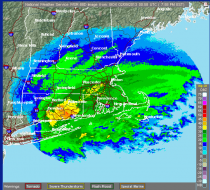
Given that December and January both ranked above 2009/10 and 2010/11 and snowcover continues above normal, suggests 2012/13 will rank in the top 5. Look at the next 10 days according to the Weatherbell.com European model snowfall forecast for the eastern US.
In a television interview today, I was asked whether global warming could explain this. I replied no, we get snow during cold periods not warm. Global warming would reduce the north south contrast and reduce the strength of storms. Also the warming models and IPCC and NOAA claimed warming would take the rain snow line most often near the major cities of the east and push it inland reducing snow for the cities. Not so.
In fact we have had 18 major impact major metro snowstorms in the east since 2000. We have had 11 in the last 4 years.
See the similarity of the winter snows this year in NYC and BOS and 1968/69.
The majority of Spain is covered in knee-deep snow and more than 930 miles worth of roads have been closed as a result, officials said. Madrid, Mancha and Navarra are among the hardest hit regions, thinkSPAIN reported, and areas in the south have already been hit hard or will be soon.
In areas in the western region of Galicia, snow in remote areas has reached as much as 5 feet deep. Meteorologists said snow is expected to hit all areas that are sea-level or higher, accompanied by winds as high as 60 mph. Madrid, the Basque Country, Castilla-La Mancha, Galicia, Asturias, Cantabria, La Rioja and Navarra are the worst-hit regions, as are parts of Castilla y León – including Palencia, Ávila, Burgos, Leoacuten and Segovia; and the provinces of Cáceres in Extremadura; Lleida in Catalunya, and Zaragoza and Huesca in Aragoacuten. In the far south of the country, all of Andalucía except for the Sevilla, Caacutediz, Huelva and Maacutelaga provinces, and Murcia in the south-east have either already been hit by snow or are expected to in the next few days. Snow-chains are needed to drive anywhere outside of major cities in all these areas, and lorries have been banned from the A-1 and A-6 westbound in Madrid. Madrid photo below.

By Joseph D’Aleo, CCM
Although some parts of the hemisphere has seen record snow, the lower 48 has seen a more erratic snow season. February has turned snowy and some big storms are about to start slamming the nation starting Friday.
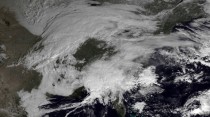
BOSTON (AP) - A blizzard of potentially historic proportions threatened to strike the Northeast with a vengeance Friday, with up to 2 feet of snow feared along the densely populated Interstate 95 corridor from the New York City area to Boston and beyond.
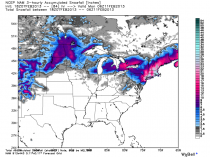
Weatherbell snowfall forecast NAM model. Pale greens in New England and New York are 2 to 3 feet. See Weatherbell.com for much more. We have been talking about this cold stormy period coming the last few weeks. Joe Bastardi and I blog daily and do videos.
From Pennsylvania to Maine, people rushed to stock up on food, shovels and other supplies, and road crews readied salt and sand, halfway through what had been a merciful winter. ICECAP NOTE: And after the fall snow last year was a lean year for snow too. The lull was to be expected after 10 major east coast storms in less than 4 years. Big snows are more common when the Atlantic (AMO) is in its multidecadal warm mode and the Pacific is cold as been the case the last half dozen years and in the 1950s and 1960s.
Before the first snowflake had even fallen, Boston, Providence, R.I., Hartford, Conn., and other New England cities canceled school Friday, and airlines scratched more than 1,700 flights, with the disruptions certain to ripple across the U.S.
Forecasters said this could one for the record books. “This one doesn’t come along every day. This is going to be a dangerous winter storm,” said Alan Dunham, meteorologist for the National Weather Service in Taunton, Mass. “Wherever you need to get to, get there by Friday afternoon and don’t plan on leaving.” The snow is expected to start Friday morning, with the heaviest amounts falling at night and into Saturday. Wind gusts could reach 65 mph. Widespread power failures were feared, along with flooding in coastal areas still recovering from Superstorm Sandy in October. Boston could get more than 2 feet of snow, while New York City was expecting 10 to 14 inches. Mayor Michael Bloomberg said plows and 250,000 tons of salt were being put on standby. To the south, Philadelphia was looking at a possible 4 to 6 inches.
“We hope forecasts are exaggerating the amount of snow, but you never can tell,” Bloomberg said, adding that at least the bad weather is arriving on a weekend, when the traffic is lighter and snowplows can clean up the streets more easily.
Amtrak said its Northeast trains will stop running Friday afternoon. The organizers of New York’s Fashion Week - a closely watched series of fashion shows held under a big tent - said they will have extra crews to help with snow removal and will turn up the heat and add an extra layer to the venue.
Blizzard warnings were posted for parts of New Jersey and New York’s Long Island, as well as portions of Massachusetts, Rhode Island and Connecticut, including Hartford, New Haven, Conn., and Providence. The warnings extended into New Hampshire and Maine.
In New England, it could prove to be among the top 10 snowstorms in history, and perhaps even break Boston’s record of 27.6 inches, set in 2003, forecasters said. The last major snowfall in southern New England was well over a year ago - the Halloween storm of 2011.
Dunham said southern New England has seen less than half its normal snowfall this season, but “we’re going to catch up in a heck of a hurry.” He added: “Everybody’s going to get plastered with snow.” Diane Lopes was among the shoppers who packed a supermarket Thursday in the coastal fishing city of Gloucester, Mass. She said she went to a different grocery earlier in the day but it was too crowded. Lopes said she has strep throat and normally wouldn’t leave the house but had to stock up on basic foods - “and lots of wine.” She chuckled at the excitement the storm was creating in a place where snow is routine.
“Why are us New Englanders so crazy, right?” she said.
At a Shaw’s supermarket in Belmont, Mass., Susan Lichtenstein stocked up, with memories of a 1978 blizzard on her mind. “This is panic shopping, so bread, milk, a snow shovel in case our snow shovel breaks,” she said.
In New Hampshire, Dartmouth College student Evan Diamond and other members of the ski team were getting ready for races at the Ivy League school’s winter carnival.
“We’re pretty excited about it because this has been an unusual winter for us,” he said. “We’ve been going back and forth between having really solid cold snaps and then the rain washing everything away”. But he said the snow might be too much of a good thing this weekend: “For skiing, we like to have a nice hard surface, so it will be kind of tough to get the hill ready.”
Massachusetts Gov. Deval Patrick ordered non-emergency state employees to work from home on Friday and urged private employers to do the same.
Terrance Rodriguez, a doorman at a luxury apartment complex in Boston, took the forecast in stride. “It’s just another day in Boston. It’s to be expected. We[re in a town where it’s going to snow,” he said. “It’s like doomsday prep. It doesn’t need to be. People just take it to the extreme.”
ICECAP NOTE: The year has some similarity to 1968/69, when the snow through January was lean but two major storms including the famous Lindsay Storm and the 100 hour blizzard followed.
CO2isGreen.org: Team of Ex-NASA Scientists Concludes No Imminent Threat from Man-Made CO2
BY PR NEWSWIRE
JANUARY 23, 2013 09:47 AM EST
WASHINGTON, Jan. 23, 2013 /PRNewswire-USNewswire/—A group of 20 ex-NASA scientists have concluded that the science used to support the man-made climate change hypothesis is not settled and no convincing physical evidence exists to support catastrophic climate change forecasts.
Beginning in February 2012, the group of scientists calling themselves The Right Climate Stuff (TRCS) team received presentations by scientists representing all sides of the climate change debate and embarked on an in-depth review of a number of climate studies.
Employing a disciplined approach of problem identification and root cause analysis honed from decades of dealing with life threatening safety issues in successfully sending astronauts up through Earth’s atmosphere and returning them safely home, the TRCS team concluded that no imminent threat exists from man-made CO2.
TRCS team is comprised of renowned space scientists with formal educational and decades career involvement in engineering, physics, chemistry, astrophysics, geophysics, geology and meteorology. Many of these scientists have Ph.Ds. All TRCS team members are unpaid volunteers who began the project after becoming dismayed with NASA’s increasing advocacy for alarmist man-made climate change theories.
H. Leighton Steward, chairman of CO2isGreen.org as well as the educational non-profit, PlantsNeedCO2.org, makes the following comments regarding the TRCS posting.
1. The science of what is causing global climate change or warming is clearly not settled and never has been. 2. There is no convincing physical evidence to support the man-made climate change hypothesis. The standard test of a hypothesis is whether it is supported by real observations, which seems to have been ignored by climate alarmists. 3. Claims made by proponents of catastrophic man-made warming are dominantly supported by non-validated computer models and the output of these models should not be relied upon by policy-makers. Some TRCS team members have been making critical decisions using complex computer models for decades. 4. There is no immediate threat of catastrophic global warming even if some warming occurs. The sea level is not going to suddenly begin a steep acceleration of its 18,000-year rate of rise. Global sea level rise is not currently accelerating despite what climate change alarmists claim. 5. The U.S. Government has overreacted to a possible catastrop hic warming. The probable negative impacts to the economy, jobs and an increased cost of food, transportation and utilities will be severe and hurt the poor and middle class the most. Real experiments show that Earth’s habitats and ecosystems could be damaged if CO2 levels are actually reduced. Environmentalists have been grossly misled to believe CO2 is a pollutant. 6. Empirical evidence shows that Earth is currently “greening” significantly due to additional CO2 and a modest warming. 7. Money saved by abandoning a premature rush to lower CO2 emissions could be better spent by continuing research on alternative energies that are not currently competitive or reliable.
Dr. Harold Doiron, team leader for TRCS and former NASA scientist, along with H. Leighton Steward, will be participating on The Hard Question panel debate on climate change tonight at 5:00pm at The National Press Club, Holeman Lounge (13 th floor) , 529 14 th Street, Washington, DC.
More information can be found at http://www.CO2isGreen.org.
Supporting scientific information can be found at http://www.PlantsNeedCO2.org.
SOURCE CO2isGreen.org
An amazing story from Russia today
Unrelenting snowfalls have caused unprecedented chaos in Russia. Over the past week, the country has seen scores of traffic accidents, flight delays and, in some cases, the complete isolation of some remote settlements and towns.
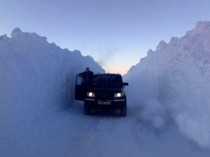
Norilsk (Photo from bigpicture.ru)
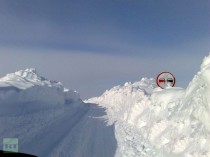
On Friday, Moscow was on a verge of traffic collapse as more than 10 inches of snow fell on the city, which is more than half of January’s average. Thousands of passengers were stranded overnight in the capital’s major airports, as several dozen flights were delayed. Muscovites woke up and found their cars, driveways and houses buried under a thick layer of snow, with city workers unable to get to smaller streets. Moscow’s Yandex app showed traffic at level 10, the highest possible, as strong winds created blizzard conditions and built imposing snow drifts.
Falling snow and ice caused many accidents due to poor visibility and bad road conditions. Moscow witnessed a 13-kilometer jam on MKAD, one of the city’s main highways, reducing speeds to 10 to 25 kph in the capital. More than 12,000 snow removal trucks worked around-the-clock to clean up the mess, but their efforts did little, with the city coming to an effective standstill.
The chair of the Duma’s transport committee called for local transport officials to face legal sanctions for failing to cope with the winter weather. “Until local bureaucrats face the wrath of the law, winter will always be a surprise occurrence. They will continue to do nothing, as people suffer,” Mikhail Bryachak told Kommersant FM radio. However, meteorologists have promised some good news for Moscow: The stormy conditions are expected to recede over the weekend.
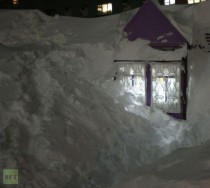
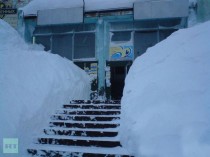
While the snowstorms have caused inconvenience for large population centers in western Russia, they have been life-threatening further east in the country. The polar circle city of Norilsk has been buried under 10 feet of snow, entire apartment blocks, markets, stores and offices were buried under snow overnight.
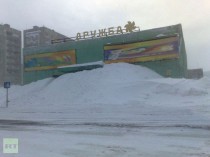
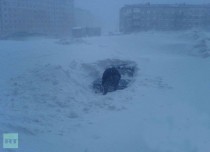
Banks of snow were as high as two people put together, reaching the second-story windows of some apartment buildings. Cars, stores, garages were blocked. Norilsk metropolitan workers were forced to dig passageways through the snow banks to create access between the outside world and the barricaded city. Meanwhile, icicles up to three feet in length have formed off the ledges of buildings, breaking at random and causing a lethal hazard for pedestrians below.
Elsewhere, the extreme weather continues. In the Altai Republic in Western Siberia, 12 Russian settlements were isolated because of the snowstorm. Seven settlements, with a total population of 1,300 people, remain cut off from the outside world due to the snow drifts. Emergency crews are currently en route to deliver needed supplies to the stranded populations. Snow accompanied by strong winds has caused flight delays in the airport of Russia’s far eastern town of Petropavlovsk-Kamchatsky. The runway has been cleared, but planes are not risking takeoff due to strong sidewinds. Flights were also delayed in Russia’s easternmost cities of Vladivostok and Khabarovsk.
More snow storms are predicted in Western Siberia and the Western Urals over the weekend. In the end of 2012, Russia saw extreme winter not witnessed since 1938. The coldest-ever December in Russia led to the evacuation of hundreds of people in Siberia, where temperatures fell below -50 degrees Celsius; Moscow also saw its coldest night ever for the season.
More than 90 Russians died during the cold snap, and more than 600 people were taken to hospital due to the extremely dangerous weather, which is 10 degrees (C) below the December norm. Nearly 200 people have died throughout Russia as a direct result of weather-related accidents and hypothermia this season, according to official statistics, although the extreme conditions have likely contributed to many more fatalities.
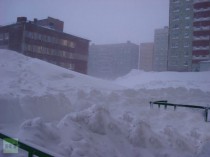
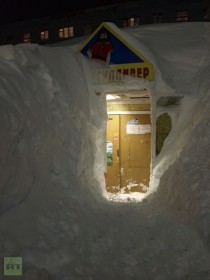
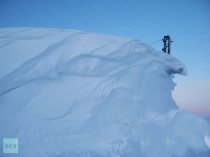
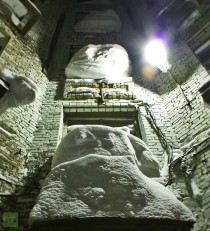
NASA: We May Be On the Verge of a “Mini-Maunder” Event.
All climate scientists agree that the sun affects Earth’s climate to some extent. They only disagree about whether or not the effect form the sun is minor compared to man-made causes.
We noted in 2011:
This week, scientists from the US Solar Observatory and the US Air Force Research Laboratory have discovered - to their great surprise - that the sun’s activity is declining, and that we might experience the lowest solar output we’ve seen since 1645-1715. The Register describes it in dramatic tones:
What may be the science story of the century is breaking this evening.
Scientists who are convinced that global warming is a serious threat to our planet say that such a reduced solar output would simply buy us more time… delaying the warming trend, but not stopping or reversing it.
On the other hand, scientists who are skeptical about global warming say that the threat is a new mini ice age. (Remember that scientists have been convinced in the past that we would have a new ice age, and even considered pouring soot over the arctic in the 1970s to help melt the ice in order to prevent another ice age. Obama’s top science advisor was one of those warning of a new ice age in the 1970s. And see this.)
NASA reports this week that we may be on the verge of another Maunder Minimum (a period with an unusually low number of sunspots, leading to colder temperatures):
Much has been made of the probable connection between the Maunder Minimum, a 70-year deficit of sunspots in the late 17th-early 18th century, and the coldest part of the Little Ice Age, during which Europe and North America were subjected to bitterly cold winters. The mechanism for that regional cooling could have been a drop in the sun’s EUV output; this is, however, speculative.
The yearly averaged sunspot number for a period of 400 years (1610-2010). SOURCE: Courtesy of NASA Marshall Space Flight Center.
The sun could be on the threshold of a mini-Maunder event right now. Ongoing Solar Cycle 24 is the weakest in more than 50 years. Moreover, there is (controversial) evidence of a long-term weakening trend in the magnetic field strength of sunspots. Matt Penn and William Livingston of the National Solar Observatory predict that by the time Solar Cycle 25 arrives, magnetic fields on the sun will be so weak that few if any sunspots will be formed. Independent lines of research involving helioseismology and surface polar fields tend to support their conclusion.
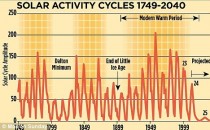
NASA explains that interactions between the sun, sources of cosmic radiation and the Earth are very complicated, and it takes an interdisciplinary team of heliophysicists, chemists and others to quantify what is really going on. And the Earth’s climate is also affected by cosmic radiation.
So even if NASA’s prediction of a period of an unusually low amount of sun spots is proven correct - it is hard to know whether that will lead to a large or small reduction in temperature trends.
Solar Variability and Terrestrial Climate

Jan. 8, 2013: In the galactic scheme of things, the Sun is a remarkably constant star. While some stars exhibit dramatic pulsations, wildly yo-yoing in size and brightness, and sometimes even exploding, the luminosity of our own sun varies a measly 0.1% over the course of the 11-year solar cycle.
There is, however, a dawning realization among researchers that even these apparently tiny variations can have a significant effect on terrestrial climate. A new report issued by the National Research Council (NRC), “The Effects of Solar Variability on Earth’s Climate,” lays out some of the surprisingly complex ways that solar activity can make itself felt on our planet.
------------
New paper finds increase in US sunshine has had 4.4 times more effect than greenhouse gases since 1996
A paper published today in the Journal of Geophysical Research - Atmospheres finds that due to a decrease in cloud cover, solar radiation has significantly increased over the US from 1996 to 2011. The authors note the change in longwave (infrared) surface radiation ‘dwarfs the [alleged contribution] from the increase of CO2 during the analysis period.” According to the paper, the natural variability due to changes in sunshine has had 4.4 times greater effect on surface radiation than increased greenhouse gases since 1996 [6.6/1.5 = 4.4]. According to the authors,
The paper adds to many other peer reviewed papers documenting a global decrease in cloud cover or ‘global brightening’ over various periods and locations beginning the the 1980’s. This decrease in cloud cover alone could account for all global warming observed since the ice age scare of the 1970’s. More
by Joe D’Aleo
Interesting weather has been occurring worldwide with snow in the Middle East, earlier frigid weather in Shanghai, snow in Tokyo and continuing brutal weather in Russia and an early heat wave in Australia where the summer monsoon - related to the MUO behavior, was slow to come on.
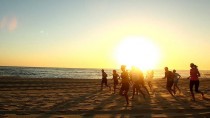
The last Australian heat and drought was in 2009. The strong La Nina of 2010/11 and the follow-up in 2011/12 brought much cooler and wetter conditions. You can see the dryness in the southwest and south the last year not as bad as in 2009. Also reservoirs were near capacity and irrigation was effective for cropping. .

As in the US, the dry winter last year has aggravated the heat central.
Here is the 7 day forecast with heat shrinking to the central.
_thumb.png)
The delayed monsoon, now over Indonesia, would normally be further south and be acting to break up the unremitting heat over central Australia. Darwin, along with much of the country, has had rainfall well below average for the past three months.
“One big question is what’s going to happen to the monsoonal trough,” said Aaron Coutts-Smith, NSW manager of climate services at the bureau. “It’s been a relatively late start to the monsoon.” The weak monsoonal conditions mean northern regions aren’t getting the cloud cover and rainfall that would normally sap some of the heat collecting in the interior.
“That can really put a lid on extreme temperatures,” he said. Sound familiar? That was the story in the US the last two year drought. related to the super La Nina of 2010/11 and the acceleration of global cooling.
An interesting phenomenon occurred similar to the dust storms we see in Arizona at the start of the monsoon season called Haboobs when thunderstorms popped and picked up dust in an awesome display of combined dust and storm clouds.
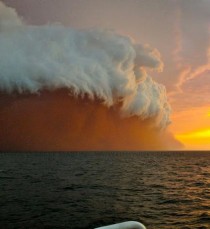
It was reminiscent of the Arizona dust storm (Haboob) in July 2011.
Cooler temperatures arrived in parts of southeastern Australia this Wednesday. This dangerous heat continued until midnight in Sydney after Tuesday’s hot temperature of 47F (about 106F). Hundreds of Sydneysiders went for a swim at midnight with a temperature that was still at 35C (95F). Sydney’s forecasted high temperature for Wednesday was 25C (77F). Surprisingly, snowflakes were flying a bit at Mount Hotham in Victoria Wednesday morning after the hot temperatures the previous day.
In contrast look at the 8 day anomaly chart for Russia, where normals are well below zero (F). Negative anomalies are approaching 40F. Wow. It shows temperatures easing in central Shanghai where frigid cold caused ice problems in Beijing and even at Shanghai with heavy snows in some spots.
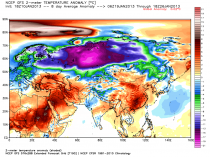
Moscow ice fog, ice bound coastal China, snow in Tokyo and cold in the Middle East and this week Europe and the US.
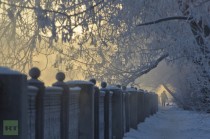
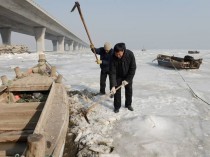
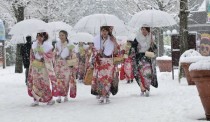
And in Jerusalem, would you believe 8 inches of snow!!!
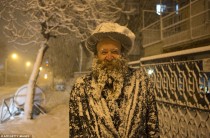
Now you may feel is the time to ‘get it on’ here in the US. Of course, we have not been short of weather stories the past 4 years with 9 major snows for the eastern cities, more for the Pacific Northwest, floods, droughts, heat weaves, Irene and Sandy also related to global cooling and low solar that causes strong persistence of weather patterns and an amplified Rossby wave pattern.
A major stratospheric warming is taking place that should result in 4 to 6 weeks of harsh weather for the Europe and North America. Sub zero cold will afflict Boston and Chicago and single digit mornings in NYC, Philadelphia and Baltimore/Washington. Snows will increase the snowcover again. The hemisphere had a record snowcover for December.

Al Jazeera has acquired Current TV, the progressive cable news station co-founded by Al Gore.

The news was reported by the New York Times’ Brian Stelter on Wednesday. Current had been aggressively looking for a buyer for some months.
Al Jazeera will replace Current’s programming with its own network. The Doha-based channel has long sought to extend the reach of its English-language service in the United States. The deal gives the network the ability to get in front of more American viewers, which has been one of its biggest challenges. Al Jazeera English launched in New York City last year, but has previously faced resistance from cable operators in other parts of the country. Though it remains controversial for many, its reporting from the Middle East during and after the Arab Spring gave it a vastly increased profile - and a new credibility - inside the US.
Sources familiar with the talks told the Times that the channel, called “Al Jazeera America,” will be based in New York, with the majority of its content created in the United States. The rest of the content would come from Al Jazeera’s English-language channel.
Current co-founder Joel Hyatt told staffers that he and Gore were “thrilled” about the deal. In a possible sign of the lingering skittishness over Al Jazeera, he said that Time Warner Cable will not carry the new channel because it had not “consented” to the acquisition. (Some accused Time Warner of political cowardice.) This will leave Al Jazeera with carriage in around 40 million homes.
The purchase brings to an end the many attempts by Gore and his partners to make Current viable over its seven-year existence. The network morphed repeatedly, from a center for short videos to a home for documentary reporting to its last iteration as a staunchly liberal cable news and opinion network. None of the moves proved successful enough. Host Eliot Spitzer put his finger firmly on the problem earlier in December when he told Fishbowl NY, “Nobody’s watching, but I’m having a great time.”
Still, the deal could benefit Gore quite a bit. Forbes estimated that the former vice president could make at least $125 million from the sale.
Dr. Larry Bell
Whew! We made it through that Mayan end of the world apocalypse thing. But don’t even begin to imagine that our doomsday problems are nearly over.
Even the Wall Street Journal breathlessly reported “Polar Ice Melt Is Accelerating: Shrinking in Greenland, Antarctica Has Sent Ocean Levels Higher, Study Says”. This ain’t just your typical run-of-the-mill, left of almost everywhere, New York Times or Washington Post global warming alarmist stuff. So it must be truth...right?
To be more specific, the article discusses a study published in the journal Science states that higher temperatures over the past two decades have contributed to a nearly half-inch rise in global sea levels since 1992, attributing about 30% of that increase to melting of polar ice sheets. The study estimates that roughly half of that 0.43 inch rise was caused by thermal expansion of the oceans (as water warms, it becomes less dense and expands), some from from runoff from melting glaciers, and the rest from melting of Greenland and Antarctica ice sheets.
And by the way, it also points out that Greenland has been a bigger contributor to all of that because Northern Hemisphere ocean currents are warmer (yup, it’s called the “North Atlantic Oscillation"… a natural cycle that shifts about every 60 to 70 years), while “Antarctica is so cold that even if warming occurs it won’t melt” at the rate seen in Greenland (according to the study co-author). The study also admitted that it’s a tricky question whether or not the overall accelerated melting of polar ice sheets can be linked to man-made climate change influences; that current climate-change models predict that some parts of the Antarctic ice sheets will grow, while others will melt; that Antarctica is not losing ice as rapidly as suggested by many recent studies; and that “The signals suggest there is no immediate threat” from rising sea levels.
What a relief! I was really worried there for a minute.
In fact, another recent study posted in Science, concluded that polar ice sheet melting has been massively overestimated. That analysis is based upon new methods that filter out “noise” from “Gravity Recovery And Climate Experiment” (GRACE) satellite data. As researcher Frederik Simons of Princeton explains, “Our technique learns enough about the noise to effectively recover the signal, and at much finer spatial scales than was possible before.”
Simons and his colleague Christopher Haig directed particular attention to the Greenland ice sheet, noting that the Antarctic ice cap is actually getting bigger. While they found that Greenland’s ice loss did consistently increase between 2003 and 2010, the change was very patchy from region to region. In addition, the enhanced detail of where and how much ice melted allowed them to estimate that the annual loss acceleration was much lower than previous research suggested, roughly increasing by 8 billion tons annually, Previous estimates were as high as 30 billion tons more per year.
Such rates of Greenland ice loss were barely larger than the margin of error in their readings, making it difficult to discern any difference between a supposed loss curve on a graph from a straight line. At the current rate, it will cause sea levels to rise about 2.4 inches over the next century. And according to the authors: “At current melt rates, the Greenland ice sheet would take about 13,000 years to melt completely, which would result in a global sea level rise of more than 21 feet (6.5 meters).”
The good news is that we are scheduled for the next Ice Age long before that. It should give Al Gore at least some comfort knowing that.
Sure, but even if Greenland and Antarctica melting is on ice for a while, what about that dreaded sea level-hiking runoff from those glaciers? After all, according to the EPA and the UN’s Intergovernmental Panel on Climate Change (IPCC), the main factors driving sea level changes now are: “the expansion of ocean water caused by warmer ocean temperatures, melting of mountain glaciers and small ice caps, and (to a lesser extent) melting of the Greenland Ice Sheet and the Antarctic Ice Sheet.”
Besides, we all knew there was a big crisis after the IPCC warned us that the Himalayan glaciers might disappear altogether by the year 2035, leading to flooding of rivers followed by imminent drought and starvation for billions of people. Well, okay, it later turned out that they made this all up, but never-the-less, those glaciers must be melting pretty fast, or they wouldn’t have worried their Nobel Peace Prize awarded minds and have scared us all to death about it...would they?
Darn! Maybe we all might have gotten a lot more sleep had we known about recent results of another GRACE satellite study published in the journal Nature that shows that Himalayan glaciers are hardly melting at all. According to John Wahr at the University of Colorado-Boulder, glaciers and ice caps in places other than Greenland and Antarctica lost about 30% less ice than had previously been estimated.
Wahr expressed surprise at these findings, saying: “One possible explanation is that previous estimates were based on measurements taken primarily from some of the lower, more accessible glaciers in Asia and were extrapolated to infer behavior of higher glaciers. But unlike the lower glaciers, many of the high glaciers would still be too cold to lose mass even in the presence of atmospheric warming.”
Not only that, it appears that glaciers in the high Asian mountain ranges...the Himalayas, the Pamir and the Tien Sha...were even much better off (presuming they really care). Previous estimates suggesting depletion rates as high as 50 billion tons of ice per year were exaggerated by a plus or minus 20 billion ton error.
And what about those sea levels? Are they rising at a terrifying rate? Although the UN’s IPCC, based upon its highly theoretical climate models have predicted an increase in the rate of global average sea level rise during the 20th century, that rate has actually been rather stable, with no significant rise over the past 50 years. The rates in the 1920-1945 period were likely to have been just as large as today’s.
So please, someone, tell Al Gore that maybe it’s time to relax. When co-anchor Katie Couric asked him on the May 24, 2006 Today show “What do you see happening in 15 to 20 years if nothing changes?...Even Manhattan would be in deep water”, he replied: “Yes, in fact the World Trade Center Memorial site would be underwater.” Then, much more recently when hurricane Sandy blew in, he knew exactly what to blame. Us of course...due to our coal fired electricity powered laptop computers, fossil fueled climate ravaging SUVs, and a host of other tide-raising influences. Wouldn’t you think that informing him about this recent research would make him feel a lot better, knowing that his new $9 million oceanview villa in Montecito, California is safe?
Oh....there’s one other thing that I wish to pass along:
Best wishes to you and your family for a cheerful holiday season and a healthy, prosperous and fearless new year!
Reprinted with permission of author. See more Larry’s work on Forbes.
By Joseph D’Aleo, CCM
UPDATE: 75% or more of the nation will be snowcovered by end of year (64.4% as of December 27). The hemisphere has again been well above normal w/r snow. For the US, two major snowstorms this week and a frigid new Year’s Eve.
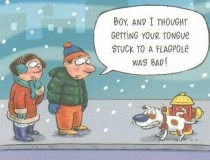
Snows will fall west south and east. Another storm in early January.
Join us at Weatherbell.com for model maps for the US and globally and much more. Daily discussions and videos. Great for the enthusiasts as well as those requiring specialized commercial services.
_thumb.jpg)
-----------------
Another bout of nonsense from UNH/UCS and NRDC environmental activists who never really look at the data. Back in 2007, the Union of Concerned Scientists (UCS), an environmental advocacy group that has seeded the once great universities with alarmists, had a meeting atop Mt. Washington where they warned ski areas that snow would vanish as global warming accelerated and the maple sugar industry would also suffer as maple trees packed their bags and retreated to Canada.
That very next winter set all types of snow records in the northeast and across all the country west to Colorado and north to Alaska. Across almost all of North America, 2007/08 was the best, or one of the best seasons ever for those who enjoy winter sports. Practically every ski area from Alaska across Canada in the Western U.S. - the Midwest and New England saw plenty of snow; some places reporting all-time record snow. Michael Berry, President of the National Ski Areas Association told the AP that “This could very well be the record year”.
Two years later, another enviro terrorist, RFK Jr., lamented that children in DC would no longer be able to enjoy winter sports like sledding because of global warming. The following winter 2009/10 set all-time snow records for the Mid-Atlantic with sled and snowshoes and skiis the best way to get around.
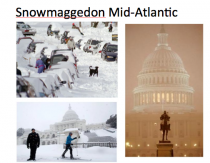
In 2010/11 major snows hit the nation again. Chicago had a blizzard (first photo). The east was buried in snow (second below New Hampshire, third Ohio churches). NYC had their third snowiest year and second snowiest month (behind February 2010).
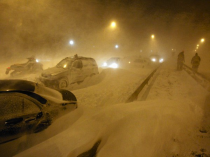

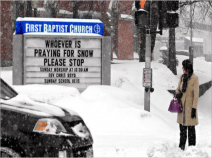
A major blitz of heavy snowstorms occured in the east in the big cities of the east Since 2000, we have had 17 major east coast storms among the 46 major impact storms NOAA has cataloged in the 56 years of the record, a full 10 such storms since the first ludicrous UNH/UCS press release.
In the hemisphere, 2009/10 had the second highest snow extent behind 1977/78. 20010/11 was third, 2007/08 4th and 2002/03 fifth. So 4 of the 5 snowiest years on record for the hemisphere have occurred in the last decade.
In an ironic twist, instead of greenhouse effect producing less snow, too much snow collapsed greenhouses in China this fall!
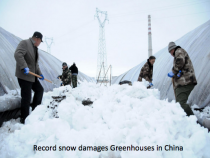
Whats more there has been no warming in any US region in the last 15 years, even with the warm winter last year.
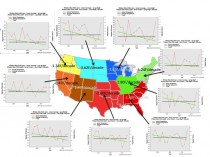
Enlarged
The Concord Monitor in a ridiculous editorial this week fed by the lefty friends at the UNH and NRDC which took advantage of the overdue warm winter last year to try again.
Last winter, fewer people visited the nation’s ski areas that at any time in the past 20 years. Half of 100 resorts surveyed opened later than normal, and 48 percent of them closed early. This winter may not be any snowier. The past decade has been the warmest on record, and temperature increases and the greenhouse gas emissions that are driving them show no sign of abating. That could doom the ski industry, and the tourism and recreation economies that depend on it, according to a new study by researchers at the University of New Hampshire, the Natural Resources Defense Council and the group Protect Our Winter.
I expect, like the Gore Effect, these clowns will be proved wrong again. It looks like many feet of snow will fall the next few weeks in the mountains. I look forward to the day when we can purge our colleges of those who are polluting the minds of our young people with their dogma. When I was a college professor for 9 years, I used to teach my students how to think not what to think. In the liberal universities today thought, that no longer happens. Unfortunately the left controls the curricula at the elementary, middle and high school levels in science and other major topics and the brainwashing begins early. We live in the"Misinformation Age”. I gave a lecture on climate factors in a Boston area school in recent years and a student stood up and said he was mad....not at me but at his school. He said he played plenty for his tuition but in two courses supposedly covering climate, he had not heard anything about the factors like multidecadal ocean cycles and the various ways cycles on the sun affect climate only greenhouse gases. Another teacher at another school who teaches a weather and climate course - in which he presented a balanced picture including all the theories and factors, was told by his environmental department head to not talk anymore about climate only weather because his students were starting to ask questions about factors he knew little about. Art Horn and I will have more to say about steps we are taking to change this including talks and courses and local cable access programming. Much of this is volunteer, so your support, no matter how small is always appreciated.
Here is an interview I did for Nashua CTV Speakupnh. I will addd the Hudson video I did with Art Horn when it is released.
UPDATE: Dr. Don Easterbrook writes:
In Washington state we have our own version of “ski areas will be a thing of the past”. For the past several years, the Univ of Wash climate group has been posting bogus claims of severe snow drought in the Cascades despite above average snowfall. They just posted another prediction that skiing will be a thing of the past, and shortly thereafter we got 80 inches of snow in 7 days, so much that it toppled about 100 tress across the road and closed the road to the ski area. We now have 176 inches, reportedly ahead of the world record year of 1100 inches.
So much for the end of skiing!
Don
By Ralph B. Alexander
December 10, 2012
Reprinted with permission of author with attribution to the NY POST
Superstorm Sandy. Parching drought across North America. A scorching midsummer heat wave in the Midwest. All these weather extremes are telltale signs that CO2 causes climate change, according to global warmists.
Indeed, the global climate-change nomenklatura gathered last week in Doha, Qatar eagerly (if grimly) cited Typhoon Bopha, which had just wreaked carnage in the Philippines, as the latest proof.
But it’s not. The link between extreme weather and global warming has as much scientific basis as the pagan rite of human sacrifice to ensure a good harvest.
Yes, the supposed connection between unusual weather events and global warming is often taken as self-evident.
It’s even been propounded in scientific papers - but not persuasively. A recent paper from Goddard Institute for Space Science chief James Hansen, for example, was quickly debunked by climate scientists on both sides of the global-warming debate.
No, the main fodder for the claim is its repetition by climate amateurs, such as New York Times columnist Paul Krugman.
The fact is that anomalous weather events, such as hurricanes, heat waves, floods, droughts and killer tornadoes, show no long-term trend whatsoever over more than a century of reliable data. Weather extremes have occurred from time immemorial, long before industrialization boosted the CO2 level in the atmosphere.
For that matter, even if there had been an uptick in extreme weather, the claim that global warming’s the cause would have to contend with the inconvenient truth that global temperatures haven’t risen for the last decade or more.
Extremes are a natural part of our climate, which constantly changes and is rarely stable for extended periods. In fact, weather extremes are the “old normal,” not a “new normal” as UN Secretary-General Ban Ki-moon proclaimed in Qatar.
Why can’t so many rational, well-educated people understand this simple fact? The answer may be superstition.
Superstition, which is rooted in fear and thought to emanate from the reptilian portion of our brains, has been part of the human psyche ever since the emergence of self-awareness in early mankind. Since then, we humans have learned to speak, write, read and live together in comparative peace. But we’re still superstitious.
Superstition about the weather in particular is hardly surprising, given the awesome power of nature. Witnessing storms, lightning and even the daily rising and setting of the sun surely induced fear and wonder in primitive cultures. The same fear and wonder are what warmists exploit today in linking weather extremes to global warming.
Scholars tell us that weather superstition often found expression in ritual human sacrifice. The Mayans, for instance, tossed victims into a limestone sinkhole to appease the rain god Chaac.
And it’s only a few centuries since superstition over the climate led to intensive witch hunts and widespread executions, usually by burning, for witchcraft.
University of Chicago economist Emily Oster demonstrated in 2004 that the most active era of witchcraft trials in Europe coincided with the Little Ice Age. Since then, other researchers have argued that chilly weather may have precipitated the Salem witch trials in the 1690s - one of the coldest periods of that epoch.
It was widely believed during the late Middle Ages that witches were capable of controlling the weather with their magic powers, and thus cause storms that could destroy harvests and hobble food production.
Things aren’t so different now. The same predisposition for superstition that caused medieval populations to fear and hunt witches can explain today’s hysteria over extreme weather. The present temperature trend is a good example. Global warmists constantly ignore the trend, labeling the flattening or even slight decline in global temperatures since 2001 or earlier as a “hiatus.”
Our obsession with weather extremes has reached such heights that it has become a knee-jerk reaction for climate-change alarmists to ascribe any unusual weather event at all to global warming. So they tell us that heat waves, floods, harsh winters, dust storms - even wildfires - are all the result of man-made CO2. But a check of records from, say, the 1930s or the 1950s, when the CO2 level was much lower than now, reveals that such events are nothing new.
Climate-change skeptics might be regarded as modern-day witches because they think that global warming comes from natural forces. However, it’s superstitious alarmists, who believe that extreme weather originates in our CO2 emissions and who have a dread of impending disaster, who are really the witches.
Ralph B. Alexander is a physicist and the author of “Global Warming False Alarm.” Buy it from the Icecap Amazon store here.
----------
‘Extreme weather events are ever present, and there is no evidence of systematic increases’
Presented at UN Climate Conference in Doha, Qatar on Dec. 6, 2012
INTRODUCTION
The man-made global warming movement has officially shifted from runaway global warming fears over to extreme weather fears. This strategic shift has been in the works for years as global average temperatures have stalled by up to 16 years. First there was a transition from “global warming” to “climate change” and now to “global climate disruption.” Some have suggested “global weirding” others have suggested a “new normal.”
At the opening of the 18 annual United Nations climate summit being held in Doha, Qatar, UN climate chief Christiana Figueres, urged governments around the world to “do something about” extreme weather. “We have had severe climate and weather events all over the world and everyone is beginning to understand that is exactly the future we are going to be looking about if they don’t do something about it,” Figueres explained at the opening of the annual UN climate summit.
In June of this year, Democrat Rep. Henry Waxman (Ca) blamed CO2 for wildfires in Colorado and floods in Florida. “It’s time to stop denying science. Extreme events like the wildfires in Colorado and the floods in Florida are going to get worse unless Republican-controlled Congress changes course soon,” Waxman explained.
Global warming proponents claimed that 2012 was a ‘new normal’ in climate with “unprecedented” weather events. Former Vice President Al Gore summed up this view when he wrote: “Every night on the news now, practically, is like a nature hike through the book of Revelations.”
Sen Boxer (D-Calif), the chair of the Senate Environment & Public Works Committee declared: “Hurricane Sandy has shown us all what the scientists sitting right in this room said the day I got the gavel, & they told us exactly what would happen and it’s all happening.”
But the latest peer-reviewed studies, data and analyses undermine claims that the weather is more “extreme” or “unprecedented”. On every key measure, claims of extreme weather in our current climate fail to hold up to scrutiny.
See climate Depot’s report to the UN climate summit in Doha on extreme weather here:
Dr. Richard Feynman, the great physicist told his students about the scientific method in this class. By his definition the theory of AGW is falsified and should be discarded.
I presented some of the evidence that taken together with that compiled by Marc Morano is more than enough to discredit/falsify global warming.
By Art Horn
In the wake of the destruction caused by hurricane Sandy there have been calls to control the weather and stop disasters like Sandy from occurring again. Apparently there are those who believe we can actually do it. On November the 1st, 2012 Mayor Michael Bloomberg of New York said “Our climate is changing. And while the increase in extreme weather we have experienced in New York City and around the world may not be the result of it, the risk that it might be, given this weeks devastation, should compel all elected leaders to take immediate action”. In his speech to the Democrat National Convention President Obama said “More droughts and floods and wildfires are not a joke. They’re a threat to our children’s future. And in this election you can do something about it.” On November the 12th, 2012 Secretary-General Ban Ki-moon addressed the UN’s General Assembly and pronounced “Finally, let me say we all know the difficulties in attributing any single storm to climate change. But we also know this: extreme weather due to climate change is the new normal. This may be an uncomfortable truth, but it is one we ignore at our peril.” In all of these statements the obvious implication is that these leaders think that if we take some kind of action, we can do something about the weather.
In all of the above statements the implied or stated method for controlling the weather is to reduce emissions of carbon dioxide. The thinking, if you want to call it that, is this. Reducing the amount of carbon dioxide in the air from 0.04% of the atmosphere to some arbitrary amount, say 0.03% or the level at the beginning of the industrial revolution in 1850, will somehow bring the weather back to “normal”. This reduction would be a whopping 0.01%. They have no idea how this reduction will actually change the weather back to how it should behave but they are sure it will work. They are so sure that they believe we should dismantle everything that has provided us with reliable, affordable energy up to this point and try something new. The EPA is already working hard to close the coal companies.
The fact of the matter is that the United States has already been reducing the amount of carbon dioxide it contributes to the atmosphere. However, the United States is only 18% of the worlds carbon dioxide emissions. World carbon dioxide emissions are continuing to rise despite our reduced input. Apparently our reduction has not been enough to change the weather back to normal so, according to Ban Ki-moon we must do more. In his address the General Assembly on 11/12/12 he said “Our challenge remains clear and urgent: to reduce greenhouse gas emissions, to strengthen adaptation to even larger climate shocks we know are on the way no matter what we do, and to reach a legally binding agreement by 2015, as states agreed to do last year in Durban.” So he thinks that a treaty, formulated and administered by the UN to control and reduce the amount of carbon dioxide in the air will give the UN (him?) the degree of control we need to stop “climate shocks we know are on the way.” In other words, control the weather.
The idea of controlling the weather is not new, in fact, it is quite old. Napoleon believed that by shooting cannons into the air he could create rain and as a result, disrupt his enemies. This became known as the “Concussion theory of rainmaking” and was used (unsuccessfully) up to the civil war. The US congress looked into controlling the weather in 1891. They brought in a retired Brigadier General named Robert Dyrenforth to launch balloons carrying explosives. The only success he had was to set off prairie fires. Enter Charles Hatfield “The Wizard of the Weather”. Around 1900 Hatfield began offering his services. He would explain to farmers that it would take time to erect his towers that would release his “moisture accelerator” concoction into the air. He always got paid first. From 1962 to 1983 the US government funded “project stormfury”. The project used cloud seeding with tiny silver iodide crystals in an attempt to weaken hurricanes out over the oceans before they struck land. In 1965 hurricane Betsey made an unusual (but not unprecedented) loop as it headed north off the coast of Florida and then slammed into Miami. Stormfury said they did not seed the hurricane but Congress didn’t believe it. Eventually the project was de-funded.
Today the latest scheme to control the weather is reducing the tiny amount of carbon dioxide in the air by an even infinitesimally tinier amount. The atmosphere that covers our planet is extraordinarily complex. It is so complex that we have a great deal of trouble forecasting what it will do just days ahead, sometime much less that that. And if you’re going to control the weather you must control the oceans as well. The oceans of the world contain more than 1,000 time the amount of heat contained in the atmosphere. Changes in the oceans that result from cyclical patterns such as El Nino and La Nina, the Pacific Decadal Oscillation and the Atlantic Multi-Decadal Oscillation have dramatic implications for the atmosphere. We would also need to control the energy output from the sun which, after all, is the primary source of energy for the planet.
Like the Wizard behind the curtain in the land of Oz, all of these people who claim they know how to control the weather are just men. They are humans who speak with profound words from high platforms in impressive locations but in the end, they have know more idea of how to change the weather than you and I.
By Noel Sheppard
Global warming skeptic and founder of the website Climate Depot Marc Morano debated climate change with Bill Nye the Science Guy on CNN’s Piers Morgan Tonight Tuesday.
PIERS MORGAN, HOST: Our big story tonight, you are so hot, America. I mean that literally. The temperature was a balmy 60 degrees this afternoon in New York just outside CNN’s studios. (Yes but November was 3.8F below normal with record snow for NYC - that’s called weather Piers) The average high temperature in December is normally 43. A warm front has flooded the lower 48 states. Quite extraordinary but is it evidence of man-made global warming? That’s tonight’s battleground America. Joining me now are Bill Nye the Science Guy and Marc Morano, the publisher of ClimateDepot.com. Welcome to you both. Let me start with you, Marc Morano, if I may. You are implacably opposed to the concept of man-made climate change. Why?
MARC MORANO, CLIMATE DEPOT: We followed the evidence. There are quite literally hundreds of factors that influence global temperature, everything from tilt of the Earth’s axis to ocean cycles to water vapor, methane, solar system. If you go down, look at the scientific literature, we are finding reams of data and new studies showing the Medieval and Roman Warm Periods are as warm or warmer today without our CO2 emissions. We have gone 16 years without global warming according to U.N. data, and we have the absurd spectacle of people claiming acts of Congress can control the weather and make hurricanes less nasty and tornadoes less frequent which by the way none of them are showing any trends at all that are unusual.
MORGAN: Okay. Bill Nye, your response?
BILL NYE THE SCIENCE GUY: Well, we start talking about the facts.
MORANO: Those are facts.
NYE: The Medieval Warm Period and Roman Warming Period, those are just in Europe.(WRONG-There was a Medieval Warm Period and it was global? According to data published by 1118 individual scientists from 641 research institutions in 46 different countries...and counting!) Let’s see if we can agree on a couple things. Do you agree that when I was a kid or when you were a kid, there was 340 parts per million of carbon dioxide in the atmosphere?
MORANO: Sure. Carbon dioxide is rising. What’s your point?
NYE: So here’s the point, is it’s rising extraordinarily fast. That’s the difference between the bad old days and now.
MORANO: Carbon dioxide.
NYE: ...much faster than ever in history.
MORANO: Let him finish, Marc. Let him finish.
NYE: It’s the rate that’s of great concern more than the actual number itself.
MORGAN: And what do you put that rate down to, Bill?
NYE: It’s human activity. You go back, this is what I say all the time. You look at the ice and you find bubbles of trapped gas from 200 years ago, let alone 1,000 years ago. There’s nobody running around with a hypodermic needle injecting bubbles of gas in ancient ice cores. That’s the ancient atmosphere in there so you can determine the composition exactly. This Medieval Warm Period is brought up quite often, but it was really a European phenomenon. It wasn’t global.

MORGAN: What are the biggest factors, the man-made factors creating the acceleration of CO2 in the atmosphere?
NYE: The biggest thing is when I was 9 years old, the Earth’s population changed from 2.999 billion to 3 billion. Now it’s in my lifetime, it’s now 7 billion people trying to live the way we lived in the developed world and we’re just burning carbon and spewing carbon dioxide in the atmosphere at an extraordinary rate.
MORGAN: Right, so Marc Morano, if there is a massively increased acceleration in CO2 in the atmosphere at the same time that there’s been a bigger than double the sizing of the population of the planet, why would that not be inextricably linked? Explain to me.
MORANO: CO2 is rising. No one is disputing that. What Bill Nye just did was waste everyone’s time explaining that CO2 is rising. The question is what impact does it have on the weather, on climate change. That is where you look at the geologic records. We’ve had warmer periods with lower CO2 and colder periods with higher CO2. You have to go way back for some of that but the bottom line is hundreds of factors are dictating our climate. The Medieval Warm Period was both Southern and Northern hemispheres. On my website there’s literally, it demolishes the idea of a hockey stick, new peer reviewed study. So the idea that Bill Nye is going around saying CO2 is up, therefore global warming is dangerous, we should be concerned, it’s not. It’s not dangerous. The bottom line is all these factors dwarf the effect of CO2.
MORGAN: Let me jump in. How do you explain the Eastern seaboard, for example, is getting some of the warmest weather it’s ever had at the same time that California has been plunged into storm after storm in the last week and you see New York last month had the worst hurricane it’s ever endured and so on and so on? How do you explain that we’re getting so many of these freakish weather patterns if at the same time you’ve got all this extra CO2 in the atmosphere and all those people now guzzling up power and energy and emitting gases that weren’t there before. Surely that is evidence, isn’t it? Wow what a crock
MORANO: No. You go to the peer reviewed literature. You are you looking at anecdotal evidence. Basically global warmists like Bill Nye say global warming will cause many bad weather events. And guess what? Bad weather events happen all the time so people look and say look, there’s more proof, there’s a bad weather event. Bottom line, big tornadoes, F3 and larger since the 1950s have dropped dramatically. Bottom line, we’ve gone the longest period without a major U.S. Category 3 or larger hurricane hitting the U.S. since 1900, maybe the Civil War. Bottom line, new study in the journal Nature, peer reviewed, no change in U.S. drought in the last 60 years. Bottom line, a new study out shows that drought has not changed in 85 to 126 years.
MORGAN: Let me, wait a minute. Wait a minute. Let me add one more bottom line before I defer to Bill Nye. He knows more about this than I do. Another bottom line, the world is indisputably getting warmer. The U.N. Weather agency said last week 2012 is on track to become one of the top ten hottest years on record. Add all the weird climactic changes we’re seeing. Bill, over to you. Piers is clueless as usual)
NYE: This will be the hottest two decades in history, in recorded history. So when you throw around a statement like the U.N. says it’s not the hottest 20 years, I got to disagree with you. There may be some surface data shows that in certain cities.
MORGAN: Here’s my point to you, Marc. It’s a straightforward one, really. If you are wrong, then the implications for the planet are utterly catastrophic.
MORANO: Not at all.
MORGAN: In other words, if you and the climate change, well, let me finish. If the anti-climate change brigade win the argument and nothing is done because you convince people nothing needs to be done and you’re wrong, then in 100, 200 years, we’ll have caused devastation for the planet that will then be irretrievable. If however you are right in what you say and this is unnecessary and overreaction and so on, what you’re seeing is a bit of economic hardship in the short term to deal with what may not be as big a problem as you think it is.
MORANO: Why is it the wrong argument? Because every proposal ever done including the United Nations Kyoto protocol would not impact the temperatures assuming you buy into their science.
NYE: We’re not talking about the temperature.
MORANO: We’re talking about a climate bill in the United States. President Obama was telling people it will keep the planet four or five degrees cooler for our grandchildren. His own EPA said it wouldn’t affect global CO2 levels let alone temperature. If you actually do, the developing world is getting 1,000-plus coal plants. There are 1.3 billion people who don’t have running water and electricity. If we actually go the route of trying to stop carbon-based energy - which has been their lifeline, which would lower infant mortality and longer life expectancy - it would be the most immoral position you can take. Bottom line is even if skeptics are wrong the solutions that the global warming alarmists have proposed would have no detectible impact on climate change.
MORGAN: Let me let Bill Nye respond to that.
NYE: If we were to begin to reduce carbon emissions, have the United States for example lead the way in this new technology, especially energy transmission, energy storage, electricity, we could change the world. We could get everybody a much higher quality of life than they would otherwise have. The problem is so many people live near the coasts and they are very old economic reasons. People lived on rivers since the beginning of human history. So as sea levels, as the world gets warmer - and I take it he doesn’t disagree the world’s getting warmer, the sea actually gets bigger. So ice is also falling off the ice sheets so that ice is up on land. This is also going to cause the sea level to rise. So for example, in the case of Sandy, which was not an especially big hurricane, the economic impact was $30 billion, and that’s in the developed world where we have the resources to deal with it. When you have people displaced on a continental scale, we’re not talking about a few people trying to get through a fence at a border between countries. We’re talking about tens of millions of people trying to move north, trying to move out of Southeast Asia. You’re going to have trouble. So the sooner we get on that problem, the better.
MORANO: These are all predictions are based on climate models that violate 81 of the 87 principles of forecasting.
NYE: I appreciate your yelling. That’s good.
MORGAN: Marc Morano, do you accept that the ocean levels are rising, that the planet is getting hotter, that CO2 emissions have dramatically increased in the last 50 years, and ice sheets are shrinking, and the planet population is doubling and accelerating at a terrifying rate, and that the combination of all these things is likely to be a major problem for the next two or three generations, and therefore, doing nothing shouldn’t really be a sensible responsible option.
MORANO: Doing nothing? First of all the United States did nothing, our CO2 emissions are dropping as we move to fracking away from coal through technology. So the idea of doing nothing, there’s nothing to do. There’s no way you can solve a non-problem. Sea level has been rising since the end of the last ice age. There’s no acceleration. Dutch Meteorological Institute said there’s no acceleration. You can look at the data, the land-based data. There’s no acceleration in sea level.
NYE: We just don’t agree on the facts. We aren’t going to get anywhere.
MORANO: Where it goes is scary, and where the horror story is in all these predictions. They come out and say it’s worse than we thought. Why? Because the predictions get scarier and scarier.
MORGAN: Okay, I respect that you have views. I don’t think they’re facts, and there are many scientists who would take issue with you about the use of the word facts. I’m going to have to wrap it up, I’m afraid. Been a spirited debate. I appreciate you both coming on. Thank you.
Read more.
Weatherbell was originally asked to do the Marc Morano part, but we had conflicts. Marc did well in this two against one battle. Both Piers and Bill Nye proved how ignorant they are about the science, using tired old debunked alarmists talking points and using anecdotes about a warm day in NYC to prove the theory. When we tried to present a snowy winter or decade of cooling (now 16 years) as evidence of falsification (Karl Popper and Richard Feynman), we were told we were cherry-picking and that we did not understand the difference between weather and climate. Sorry boys and girls, I taught weather and climate for 10 years at the college level. I grew up with Mr. Wizard, a real scientist. Not a political phoney actor - a Soupy Sales clown but without the personality. And somehow in CNN’s mind, an English accent portrays intelligence. Sorry Piers did a good job promoting Susan Boyle and in evaluating talent but he is no talk show hope and not a fair interviewer like Larry King.
BTW, I was busy yesterday and today doing cable access shows on weather and climate promoting the truth about climate change and also the efforts, Joe Bastardi, Ryan Maue, I and our team at Weatherbell.com are doing to provide accurate forecasts of storms like Sandy. JB was on cable over a week in advance warning of a hit on NYC and NJ. Please remember to join us as subscribers, a great Christmas gift to a weather enthusiast. Also please help Icecap pay for our expenses. We get no grants unlike Mann at Real Climate who gets a blank check from Fenton Communications to peddle Bad Science and has NASA look the other way as Gavin Schmidt spends his working hours at NASA posting in Real Climate. We get no money for doing interviews on cable large and small. Art Horn is driving 6 hours to join me tonight at HIS expense. Even small amounts are appreciated. BTW, your cable access channels are looking for programming. Put together a powerpoint and got down and present it. I once did one in Bloomfield Michigan several years ago to a club that was shown over 5 dozen times and had the blood boiling at the University and Wunderground. I have worked 7 days a week since early 20111 and the inception of Weatherbell. When I do these other things or post on Icecap, it is during breakfast or in place of dinner. That is how strongly I feel about the truth and getting the message out. It is a battle we can’t afford to lose, quite literally.
------
Marc Morano Exposes Bill Nye’s Astonishing Ignorance Of Climate Science In Debate On CNN
NOTRICKSZONE
I thought Bill Nye was supposed to be well-informed about science. Boy, was I wrong. Marc Morano Exposes Bill Nye’s astonishing ignorance of climate science. It started as soon as Nye opened his mouth at the 1:39 mark, he claimed the Medieval Warm Period and Roman Period were isolated incidents occurring only in Europe. He repeated it again 1t 2:55.
That claim was already refuted 10 years ago. Since then there are dozens of studies from every corner of the globe where proxy data clearly show that the aforementioned optimums occurred in cycles WORLDWIDE. Incredibly, Bill Nye thinks that the global temperature was more or less constant before human CO2 emissions. Even Michael Mann no longer believes that.
At the 2:20 mark, Nye then says that the rate of CO2 rise is of great concern. False. What is of concern is CO2’s impact on global warming. All scientists agree that a doubling of CO2 will lead only to about 1 to 1.5C of warming by itself. CO2’s impact is turning out to be far less than originally feared. In fact “the rapidly rising CO2” has resulted in no global warming in over 15 years!
Then at about the 3:35 Morgan and Nye seem to claim that the climate is directly related to the human population, i.e. when population rises, then temperature rises. Now we are getting a good idea of just how bad Nye and Morgan’s science truly is.
Throughout the debate, Nye and Morgan’s arguments are carried by fear and horror visions. You can’t help but to think they are a bit on the hysterical side.
At the 4:30 mark, Morgan then totally confuses weather with climate. “How do you explain the warm weather today? Why is it we have all this freakish weather just when we have so many people? That’s evidence isn’t it?” The CNN host has now ventured into comedy science. It’s again that psychological affliction of insisting that the world is coming to an end, and not being able to live without that.
At the 6:30 mark it’s the old “precautionary principle” line. It’s a wonder these people ever hop onto a plane or drive a car.
The rest of the debate is pretty much Bill Nye and Piers Morgan neurotically worrying about the phony computer-generated horror scenarios 100 years down the road, and confirm they believe that global temperatures are rising (they aren’t, they’re flat) and that sea level rise is accelerating (it isn’t, in fact it is decelerating).
Finally, I couldn’t help noticing that their primary worry is population growth for them there are just too many people on the planet. They need more “Lebensraum”.
Not the first time Nye made a complete fool of himself and exposed his leanings on CNN. See this .





